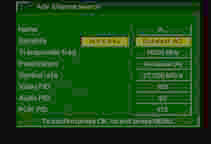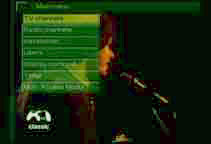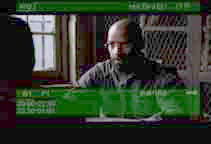Micronik TVBox 1200S - The box that almost made it (Page 3 of 5)
The Setup
 Initial
booting of the 1200s was full of nice surprises. There are a few screens with
step-by-step help to follow, and then once you get to the actual set-up menus,
choice is simply overwhelming. You can pick from predefined LNB types, from
standard to C band, use motors and switches as long as your equipment is compatible
with any of the three DisEQc standards (1.0, 1.2, 2.0) or MiniDisEQc; 22kHz
is also on the list.
Initial
booting of the 1200s was full of nice surprises. There are a few screens with
step-by-step help to follow, and then once you get to the actual set-up menus,
choice is simply overwhelming. You can pick from predefined LNB types, from
standard to C band, use motors and switches as long as your equipment is compatible
with any of the three DisEQc standards (1.0, 1.2, 2.0) or MiniDisEQc; 22kHz
is also on the list.
DisEQc 1.2 compatibility is by the book - you can set limits, adjust final positions,
override defaults. We have even went as far as defining midfocus for Astra and
HotBird using Stab H-H motor and dish with two LNBs attached. Not that there
was any sense in twin LNB setup and rotor, but neverless excercise was successfull.
We couldn't test DisEQc 2.0 features, as there is no available motors of this
standard on the Europan market. Most of satellites visible from Europe is already
predefined so setting any motorised dish is childs play, you can trust us on
that. In our second setup we removed motor and used standard twin LNB set-up
with a DisEQc switch and the dish pointing towards Astra 19.2 and Hot Bird 13
degrees East. Channel search from both was very fast, around 6 minutes for each
satellite.
One of the charming
elements of the Micronik 1200s is its front panel, or rather alphanumeric, ten
digits VFD to be precise. All menus you go through and channel names (once set-up)
you watch appear on the nice blue display (green in older versions) right there
on the front panel of the receiver. Nice. This also has a contrast control in
OSD (see bottom of the page for a photo).
 After
initial set-up, we quickly discovered that organising channels is a much bigger
task than first thought. Since there is no bouquets or grouping of any kind
you have to delete unwanted content one by one. Moving channels is also a bit
of a hassle; similar to cheaper receivers each and every channel has to be swapped
with another by typing new destination number on the list. There is no option
of moving channels from place to place by dragging them up and down with scrolling
buttons or any other choices for that matter. In the 'TV Channels' menu you
can also rename channels but the changes apply only to the VFD display, OSD
banner on the screen will always read name from the air and stay intact.
After
initial set-up, we quickly discovered that organising channels is a much bigger
task than first thought. Since there is no bouquets or grouping of any kind
you have to delete unwanted content one by one. Moving channels is also a bit
of a hassle; similar to cheaper receivers each and every channel has to be swapped
with another by typing new destination number on the list. There is no option
of moving channels from place to place by dragging them up and down with scrolling
buttons or any other choices for that matter. In the 'TV Channels' menu you
can also rename channels but the changes apply only to the VFD display, OSD
banner on the screen will always read name from the air and stay intact.
 The
Micronik 1200S hasn't got any functions to change video or audio PID, so if
any of your channels was fetched incorrectly in auto search mode, you have to
delete it first and then input the required settings in the manual search menu.
Now, interesting part of this operation is that 1200S in manual search mode
looses the ability to auto detect channel names, so whatever you are looking
for has to be named first...
The
Micronik 1200S hasn't got any functions to change video or audio PID, so if
any of your channels was fetched incorrectly in auto search mode, you have to
delete it first and then input the required settings in the manual search menu.
Now, interesting part of this operation is that 1200S in manual search mode
looses the ability to auto detect channel names, so whatever you are looking
for has to be named first...
 The
OSD itself is minimalist, displayed with a single colour background (blue, grey
and green to choose from) with full control over its gamma and transparency.
The interesting bits are all hidden in the channel menus - full technical information,
program details and EPG. Soundtrack language choice is automatic for all channels
rather than by setting audio PID, so you can either listen to all channels in
their primary broadcast language (dubbing) or all in secondary one (usually
original version).
The
OSD itself is minimalist, displayed with a single colour background (blue, grey
and green to choose from) with full control over its gamma and transparency.
The interesting bits are all hidden in the channel menus - full technical information,
program details and EPG. Soundtrack language choice is automatic for all channels
rather than by setting audio PID, so you can either listen to all channels in
their primary broadcast language (dubbing) or all in secondary one (usually
original version).
 Designers
at Micronik seemed to have a bit of a problem with the widescreen detection,
hence all channel names and descriptions are displayed roughly in the middle
of the 4:3 screen with a huge empty gap of clear picture on the bottom. The
choice of 10 OSD languages promised in manual is in real life reduced to two;
German or English. The other languages are simply missing. At least in the 12-83
beta OS our box was shipped with. Well, it's still one language more than the
manual itself offers - our 1200S came only with German technical papers.
Designers
at Micronik seemed to have a bit of a problem with the widescreen detection,
hence all channel names and descriptions are displayed roughly in the middle
of the 4:3 screen with a huge empty gap of clear picture on the bottom. The
choice of 10 OSD languages promised in manual is in real life reduced to two;
German or English. The other languages are simply missing. At least in the 12-83
beta OS our box was shipped with. Well, it's still one language more than the
manual itself offers - our 1200S came only with German technical papers.
Despite our best
intentions, we couldn't get the 1200S to display EPG on any of the channels
offering one. Oh well, at the end of the day it does say 'beta' in the OS version
Micronik ships it's boxes with. Teletext on the other hand worked like a charm.
Moving from one
channel to another is swift and incredibly quick. 1200S is definitely the fastest
receiver we have ever had in our hands. Unfortunately speed seems to come at
the cost of stability (details in a sec.). While surfing we also noticed that
the remote control, although very comfortable, has quite a narrow IR bandwidth
and even with the 20° receiver most of the time couldn't see our commands.